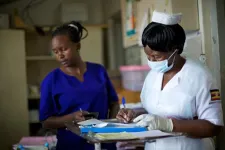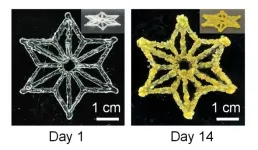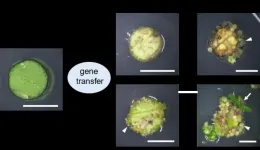(Press-News.org) Washington, D.C.—Scientists have discovered that calcium plays a significant role in enhancing the resistance of potato plants to bacterial wilt. This disease causes worldwide losses of potatoes costing $19 billion per year. The findings open up new avenues for integrated disease management strategies, including the potential for calcium amendments to soil as a part of a comprehensive approach to controlling bacterial wilt in potatoes. The study is published in Applied and Environmental Microbiology, a journal of the American Society for Microbiology.
Ralstonia solanacearum species complex (RSSC) is a phytopathogenic bacterial group that causes bacterial wilt in several crops. “Our research team has been dedicated to studying the Ralstonia solancearum-potato pathosystem for years, with a primary focus on developing potato varieties with resistance to bacterial wilt,” said corresponding study author María Inés Siri, Ph.D., from the Department of Biosciences, University of the Republic, in Montevideo, Uruguay. Pathosystems like this one are subsystems of ecosystems that specifically are defined by parasitism, where the parasite is any species that spends a significant part of its lifespan inhabiting and getting nutrients from a host. Siri said that until now, the relationship between the potato plant ionome (mineral and trace elements composition) and resistance levels to RSSC has not been addressed.
In the new study, the researchers initiated their investigation using potato plant genotypes with contrasting levels of resistance to bacterial wilt. This approach allowed the researchers to examine how different levels of natural resistance within the plants could be linked to their mineral compositions. The researchers assessed the mineral content in various parts of the potato plants, such as the xylem sap, roots, stems and leaves, focusing on the relationship between these minerals, particularly calcium, and the plants' resistance to bacterial wilt.
Following this mineral assessment, the scientists explored the impact of calcium on several aspects related to the virulence of the pathogen, including its growth rate, ability to form biofilms and motility. Furthermore, they evaluated calcium's effect on enhancing plant resistance through controlled inoculation trials, providing a comprehensive view of how calcium supplementation could potentially bolster the potato plant's defense mechanisms against bacterial wilt.
The team discovered a positive relationship between the concentrations of calcium and the resistance levels of potato genotypes to bacterial wilt. They also found that calcium supplementation to the potato was able to significantly reduce the growth rate of the pathogen causing the wilt and negatively affect the pathogen’s ability to form biofilms and move, which are crucial for its virulence and ability to cause disease.
“There are several exciting directions for future research stemming from our findings,” Siri said. “We plan to delve deeper into understanding how calcium affects the pathosystem at the transcriptomic level, including plant defense mechanisms and the pathogen's virulence. We also aim to explore the plant microbiome's role in resistance and develop practical field management strategies that incorporate calcium fertilization.”
The study is the first to utilize microfluidic chambers to monitor pathogen growth and biofilm formation under conditions mimicking the plant's vascular system, said Siri. This innovative approach has provided valuable insights into how calcium supplementation can impede the pathogen's ability to form biofilms, a key factor in its virulence. “Additionally, this methodological advance is not just limited to our current study, but also holds promise for future research on this important vascular pathogen,” Siri said. “By offering a new tool for detailed observation and analysis, our approach could be leveraged in further studies to unravel the complexities of plant-pathogen interactions and to explore novel disease management strategies.”
###
The American Society for Microbiology is one of the largest professional societies dedicated to the life sciences and is composed of 36,000 scientists and health practitioners. ASM's mission is to promote and advance the microbial sciences.
ASM advances the microbial sciences through conferences, publications, certifications, educational opportunities and advocacy efforts. It enhances laboratory capacity around the globe through training and resources. It provides a network for scientists in academia, industry and clinical settings. Additionally, ASM promotes a deeper understanding of the microbial sciences to diverse audiences.
END
Calcium can protect potato plants from bacterial wilt
2024-05-01
ELSE PRESS RELEASES FROM THIS DATE:
Virtual reality environment for teens may offer an accessible, affordable way to reduce stress
2024-05-01
Social media. The climate crisis. Political polarization. The tumult of a pandemic and online learning. Teens today are dealing with unprecedented stressors, and over the past decade their mental health has been in sustained decline. Levels of anxiety and depression rose after the onset of the COVID-19 pandemic. Compounding the problem is a shortage of mental health providers — for every 100,000 children in the U.S., there are only 14 child and adolescent psychiatrists.
In response to this crisis, University of Washington researchers studied whether virtual reality might help reduce stress ...
Join us in honoring the 2024 American Gastroenterological Association Recognition Awards recipients
2024-05-01
Bethesda, MD (May 1, 2024) — The American Gastroenterological Association (AGA) has announced the 2024 recipients of its annual recognition prizes, given in honor of outstanding contributions and achievements in gastroenterology.
"AGA is delighted to present the recipients chosen for the 2024 AGA Recognition Prizes. We extend our gratitude to all the nominators for their submission of nomination letters, and to the diligent selection committee members for their work in identifying these exceptional individuals from ...
Resource-appropriate cancer care, including coexisting health issues of HIV and cancer, to be addressed during meeting in Nairobi
2024-05-01
NAIROBI, KENYA [May 1, 2024] — Local and global experts are meeting in Nairobi, Kenya to update clinical practice guidelines as part of ongoing work with Allied Against Cancer—a collaboration between the National Comprehensive Cancer Network® (NCCN®), African Cancer Coalition (ACC), American Cancer Society (ACS), and Clinton Health Access Initiative (CHAI). The meeting brings together subject matter experts to update NCCN Harmonized Guidelines™ for Sub-Saharan Africa, featuring updates for treating cancer in people with HIV and other important ...
Marriage of synthetic biology and 3D printing produces programmable living materials
2024-05-01
Scientists are harnessing cells to make new types of materials that can grow, repair themselves and even respond to their environment. These solid “engineered living materials” are made by embedding cells in an inanimate matrix that’s formed in a desired shape. Now, researchers report in ACS Central Science that they have 3D printed a bioink containing plant cells that were then genetically modified, producing programmable materials. Applications could someday include biomanufacturing and sustainable construction.
Recently, researchers have been developing engineered living materials, primarily relying on bacterial ...
Friends with health benefits: How the buddy system pays off when pursuing goals
2024-05-01
Weekly targets, annual resolutions, five-year plans—all of them so troublingly elusive. With best intentions, most of us fail to stick with the goals we set.
Next time, consider pursuing them with a friend.
New field research by Assistant Professor Rachel Gershon, published in Management Science, suggests that pursuing our goals with friends may make them more attainable. Gershon, along with Cynthia Cryder of Washington University and Katy Milkman of the University of Pennsylvania, ...
Novel genetic plant regeneration approach without the application of phytohormones
2024-05-01
For ages now, plants have been the primary source of nutrition for animals and mankind. Additionally, plants are used for the extraction of various medicinal and therapeutic compounds. However, their indiscriminate use, along with the rising demand for food, underscores the need for novel plant breeding practices. Advances in plant biotechnology can address the problems associated with food scarcity in the future by enabling the production of genetically modified (GM) plants with higher productivity and resilience to the changing climate.
Naturally, plants can regenerate an entire new plant from a single ‘totipotent’ cell (a cell that ...
ACS inaugural report shows mortality for preventable cancers among native Hawaiian and other Pacific Islanders in U.S. is 2-3 times as high as white people
2024-05-01
ATLANTA, May 1, 2024 — The American Cancer Society (ACS) today released a first-of-its-kind Cancer Facts & Figures for Asian American, Native Hawaiian, & Other Pacific Islander People, 2024-2026. This report shows that despite limited disaggregated data, there is wide variation in the cancer burden among ethnic groups that make up this fast-growing population. Cancer is the second-leading cause of death in the United States nationally but ranks first in Chinese, Filipino, Korean, and Vietnamese individuals, with lung cancer the leading cause of death in men of every Asian American, Native ...
ChatGPT fails at heart risk assessment
2024-05-01
SPOKANE, Wash. – Despite ChatGPT’s reported ability to pass medical exams, new research indicates it would be unwise to rely on it for some health assessments, such as whether a patient with chest pain needs to be hospitalized.
In a study involving thousands of simulated cases of patients with chest pain, ChatGPT provided inconsistent conclusions, returning different heart risk assessment levels for the exact same patient data. The generative AI system also failed to match the traditional ...
Improved AI process could better predict water supplies
2024-05-01
PULLMAN, Wash. -- A new computer model uses a better artificial intelligence process to measure snow and water availability more accurately across vast distances in the West, information that could someday be used to better predict water availability for farmers and others.
Publishing in the Proceedings of the AAAI Conference on Artificial Intelligence, the interdisciplinary group of Washington State University researchers predict water availability from areas in the West where snow amounts aren’t being physically measured.
Comparing ...
A blood test for stroke risk? Study finds network of inflammatory molecules may act as biomarker for risk of future cerebrovascular disease
2024-05-01
A simple blood test could allow doctors to determine whether a person may be at higher risk for stroke or cognitive decline during their lifetime, according to a new UCLA Health study.
The study, published in the journal Stroke, found that measuring concentrations of a network of inflammatory molecules in the blood could allow doctors to calculate a risk score for susceptibility for cerebral small vessel disease – a common cause of stroke and a contributor to cognitive decline found especially among the elderly.
Currently, the only way to determine a person’s risk for cerebral vascular diseases has been ...




